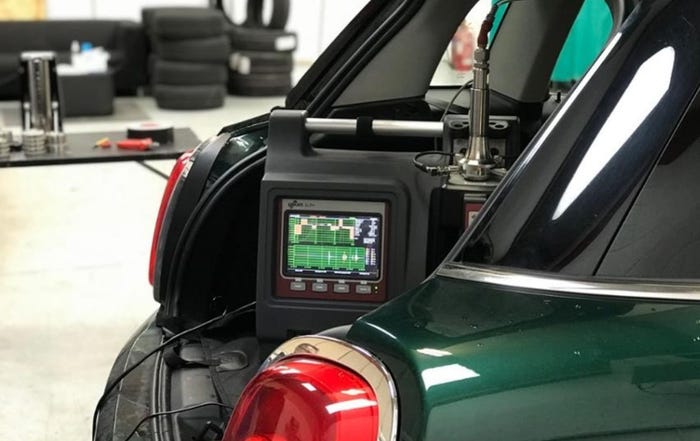Well-Done Tucson Shows Nobody’s Perfect
Theta II 4-cyl. in Hyundai’s CUV covers all the bases and really shines in heavier, urban traffic. But the electric steering proves unresponsive in hilly switchbacks.


BEVERLY HILLS, CA – You would think Hyundai Motor Co. Ltd. could do nothing wrong these days.
The Korean auto maker’s first foray into the luxury-car segment produced the Hyundai Genesis sedan, which in its two years of existence has been showered with awards, including back-to-back Ward’s 10 Best Engines nods.
In the U.S., its performance in third-party quality, reliability and satisfaction studies has catapulted, and the auto maker’s growing fleet ranks among the industry’s most fuel efficient. Its latest promise is to trim the weight of its vehicles 10% in the next five years.
Not surprisingly, Hyundai Motor America’s sales and market share are growing at a time when others see double-digit decreases and are fighting desperately to hold their portion.
Into this environment arrives the redesigned-for-’10 Hyundai Tucson cross/utility vehicle, which has so many good points, such as fuel economy and exterior styling, it would be easy to overlook its few shortcomings.
That is, if those shortcomings weren’t so darned obvious.
The principle offender is a weak electric power steering system from Korean parts maker Mando Corp. Not just poorly calibrated, which obscures on-center feel, the system also lacks the responsiveness other auto makers, notably Volkswagen AG, have been able to dial into their electrically assisted setups.
However, the good news is the funky steering varied by degrees between front- and all-wheel-drive models, as well as wheel and tires sizes, suggesting the Tucson’s fuel-saving EPS may be a work in progress.

Tucson exterior design sleeker.<link rel=
">
Of course, Hyundai may have been better off not staging nearly every mile of test driving up and down the switchback-silly roads of Topanga Canyon State Park here.
The route shows off Tucson’s rock-solid chassis, its stout 2.4L 4-cyl. and nifty new downhill-brake and hill-start assist controls, but the same twisties expose its muddled EPS.
And while Hyundai has made tremendous strides with its interior styling, climate-control knobs feel chintzy and glossy plastic inserts smudge easily.
The auto maker also adds the first available panoramic sunroof to its vehicle lineup with the new Tucson, a feature sure to wow Hyundai’s budget-conscious customers. But wind noise is excessive, even at moderate speeds.
Sunroof closed, however, the interior is pleasantly quiet, reflecting the extensive parts modifications Hyundai has made on the new model to mitigate noise, vibration and harshness.
’10 Hyundai Tucson GLS
Vehicle type | front-engine, 2WD 5-passenger CUV |
Engine | 2.4L DOHC 4 cyl. |
Power (SAE net) | 176 hp @ 6,000 rpm |
Torque | 168 lb.-ft. (233 Nm) @ 4,900 rpm |
Compression ratio | 0.5:1 |
Transmission | 6-speed automatic w/manual mode |
Wheelbase | 103.9 ins. (263.9 cm) |
Overall length | 173.2 ins. (439.9 cm) |
Overall width | 71.7 ins. (182.1 cm) |
Overall height | 66.3 ins. (160.7 cm) |
Curb weight | 3,203 lbs. (1,452.8 kg) |
Base price | $22,500 (as tested) |
Fuel economy | 23-31 mpg (10.2-7.6 L/100 km) |
Competition | Honda CR-V, Toyota RAV4, Nissan Rogue, Ford Escape, Subaru Forester, Volkswagen Tiguan, Jeep Compass/Patriot |
Pros | Cons |
Shines in urban setting | Unresponsive steering |
Tons of safety features | Some glossy materials |
Sleek, modern styling | Dude, where’s my GDI? |
All-in-all, Hyundai executes a fine interior with the Tucson. A 2-tone black and saddle motif is especially attractive and gives the CUV a modern, upscale look. Nooks and crannies for wallets, phones and iPods are plentiful.
Kudos to Hyundai bean counters for green-lighting a head restraint for the second row’s center passenger, despite base models with a sticker starting at $19,000.
The third headrest is not required in the U.S. and many auto makers skip it to save a buck, but in this case Hyundai is getting out in front on the safety curve.
To call the exterior styling of the new Tucson an improvement over its dull predecessor would be an understatement.
It receives a sculpted hood; mischievous-looking grille; cat-like headlamps with matching foggers; standard 17-in. and optional 18-in. wheel and tire packages that both fill the fenders tightly; and side sill molding that makes the CUV appear in motion while at a standstill.
Hyundai also lowers the greenhouse a bit to add to Tucson’s sleek look.
Taken together, it’s a fetching exterior that should stand out nicely in a segment full of homogenous CUVs.
As for the Tuscon’s Theta II 4-cyl., it covers all the bases but really shines in heavier, urban traffic. Mated to a 6-speed automatic transmission that always seems in the proper gear, the 176-hp I-4 should make a lot of commuters happy.
Looking ahead, an eagerly anticipated 200-hp direct-injection gasoline version of the engine bows in the ’11 Hyundai Sonata midsize sedan launching in the coming weeks.
Hyundai product planners say they could not get the DIG engine ready in time for the Tucson, but promise it is coming to the CUV. There are no plans for a Tucson hybrid, they say.
Available in both FWD and AWD configurations, the new Tucson began arriving at U.S. dealers last month. It should provide the auto maker with even more momentum.
But while the redesigned CUV deserves praise, the Tucson also proves nobody is perfect – not even Hyundai.
Read more about:
2010About the Author
You May Also Like





